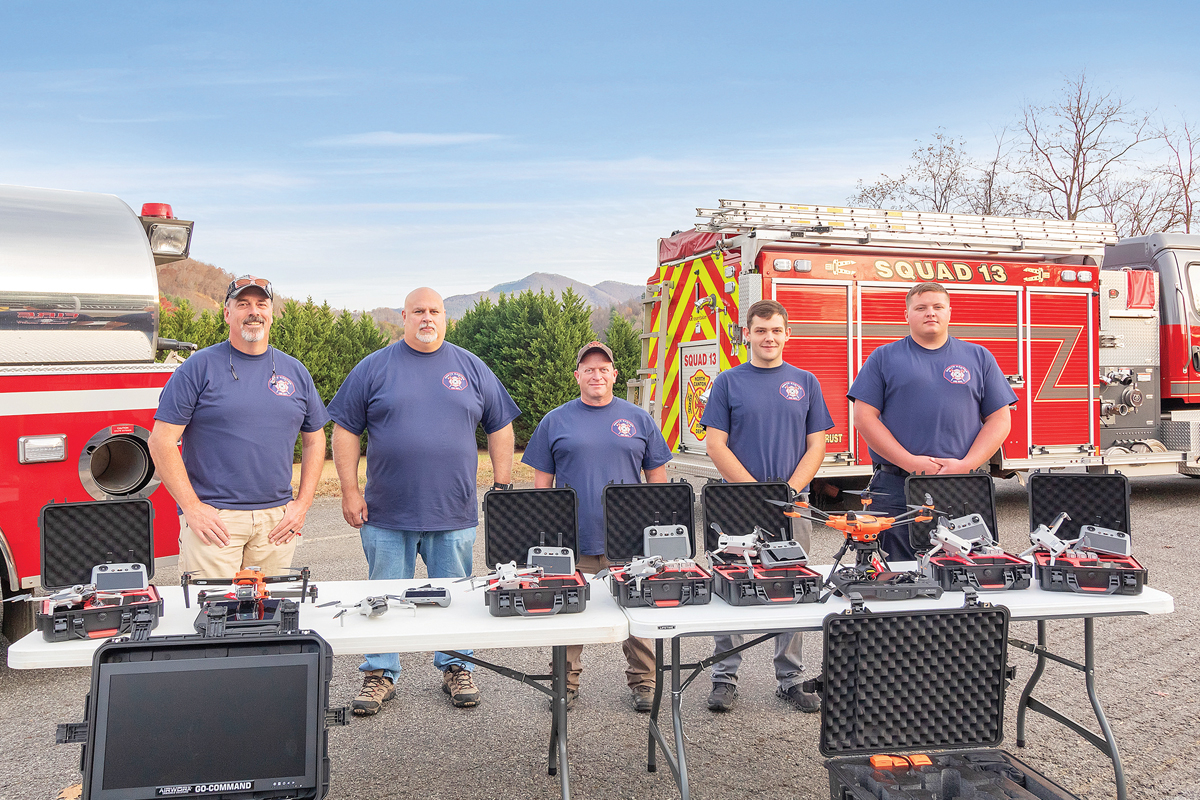Up in the air: North Canton Fire Department puts eyes in the sky to save lives
 Pictured from left to right are members of North Canton Fire Department’s drone unit — Allen Newland, Tony Pope, Steve Kelley, Chance Best and Billy Hannah. Not pictured are Levi Allen and Christian Wilkie. Julie Newland photo
Pictured from left to right are members of North Canton Fire Department’s drone unit — Allen Newland, Tony Pope, Steve Kelley, Chance Best and Billy Hannah. Not pictured are Levi Allen and Christian Wilkie. Julie Newland photo
As technology evolves, every entity and industry finds new and innovative ways to use those advances to improve their operations.
Likewise, first responders from police to firefighters to emergency services use the latest, greatest changes to improve the way they operate. Over the last decade, one of the most valuable new tools has been the drone, a typically small and shifty aircraft that can be used in even the most dangerous situations, sparing those first responders from some of the worst dangers.
Now the North Canton Fire Department in Haywood County has officially created its own drone unit.
The unit is made up of seven members, each of whom keeps a small drone with them in case they need it when responding to any call at any time. In addition, the department has two larger drones with greater capabilities. Heading up the drone unit is volunteer Allen Newland, an experienced operator who began flying remote controlled aircrafts with model planes back in 1974. Newland said it’s been fun to see RC aircraft technology develop into what it has.
“It’s mind blowing to see how well these things fly,” he said, adding that they’re highly maneuverable, but that maneuverability isn’t often necessary. “They can hover if anything goes wrong, and they have obstacle avoidance.”
Steve Kelley has been the fire chief at North Canton for 12 years. He said that when he explored the opportunity to get drones for his department in 2021, he reached out to agencies for which NCFD provides mutual aid, meaning they respond to certain calls that may require more hands. There was plenty of interest, and the program was born.
Related Items
It took about a year and a half to get the drone unit off the ground. The department used funds available through a COVID assistance program to fund its beginning. Kelley said he’s been happy with how the program has been — and can be — used.
“It’s a resource that can be very valuable, whether it be for forest fires, whether it be for structure fires,” he said.
And there’s a whole other host of uses. The larger drones not only have regular cameras like the smaller ones; they also have thermal-imaging ability, which can be used to find missing persons, including lost hikers, or possibly even fugitives.
In a recent Haywood County Commission meeting, Sheriff Bill Wilke talked about how his deputies have used drones, noting that two were deployed when aiding the Waynesville Police Department during a standoff earlier this year. During that standoff, a man had barricaded himself within his own residence on Prevost Street near the Waynesville Inn after firing shots at someone.
While the Waynesville Police Department has drones of its own, when it comes to a dangerous situation, it’s sometimes a matter of the more the marrier, considering they can be used to get a handle on what may be happening inside any location without putting an officer or deputy in harm’s way.
Waynesville Police Chief David Adams discussed his own department’s use of drones, which have been largely operated by Detective Tyler Howell. Adams said that in addition to the situation on Prevost Street, drones were also used recently when searching for a missing woman, whose body was ultimately discovered near a rock quarry off Allens Creek.
Adams said his office has three devices, including one of the larger ones that utilizes thermal imaging. He said that the tool can be used in a manhunt but was more recently used to locate a missing juvenile. On busy days downtown, such as parades and street festivals, drones can be used to monitor for suspicious activity.
Drones have investigative applications, as well, and can document a crime or crash scene from above. There’s even software that can create 3D models of scenes.
“We have used those drones quite a bit, and we’re looking at developing that program,” Adams said.
For NCFD, even after a structure fire appears to be out, there are often hot spots — smoldering material hidden from the naked eye — that can reignite. The department uses drones with thermal imaging to try to identify those hot spots so they can be broken up. While his firefighters also have their own devices that can check for hot spots, having the eye in the sky has made a difference.

Here’s a look at how a drone can use thermal imaging capabilities to spot a person on the ground. A Shot Above photo
“It’s especially important for eaves and roofs since those can be dangerous,” Kelley said.
Drones have also been used in some of the recent forest fires across Western North Carolina in similar ways. But the small aircrafts’ usages in the woods isn’t limited to that. In addition to man hunts, they can be used in search and rescue efforts deep in the region’s forests where access is limited. Not only can the thermal camera be used to locate people in distress, the larger drone can bring along up to a 6-pound payload. In some situations, a hiker may need water, food, medicine or a fire starter. Newland pointed out that when a hiker is out of cell phone range, a drone can bring instructions the person can use to make their own rescue safer. Sometimes, they need to be told simply to stay put.
“It’s harder to reach a moving target,” he said. “We can say ‘we know where you are,’ so then we can come back and drop off a first aid kit if we need to. We can drop a radio since the county has some that are small enough.”
It’s impressive that North Canton has seven pilots, considering the Federal Aviation Administration (FAA) licensing process — necessary for drone operation — is fairly rigorous, and constant practice is vital to effective operation during a casualty or investigation. And other nearby agencies have appreciated access to the technology. Not only have the other fire departments in Haywood County benefitted, but even those in western Buncombe County have benefitted since they have mutual aid agreements with NCFD.
While there will no doubt be more developments and new ways drones are used by first responders, each of those interviewed by the Smoky Mountain News who have employed the devices said they’ve already proven invaluable.
“They’ve been great for us, and I’m glad we have them,” Kelley said. “If they save even one life, they’ll be worth every cent.”













